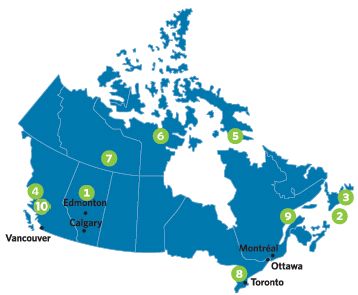
Oil Sands News
1. Encana Corporation and Phoenix Duvernay Gas, a wholly owned subsidiary of PetroChina, have entered into a joint venture arrangement to explore and develop Encana's undeveloped Duvernay land holdings in west-central Alberta. Under the terms of the agreement, PetroChina will gain a non-controlling 49.9% interest in Encana's approximately 445,000-acre Duvernay play, estimated to contain approximately nine bbbl of oil, in exchange for $2.18 billion. Encana will remain operator and retain a 50.1% controlling interest in the partnership. The partners anticipate a total combined investment of $4 billion in new drilling, completion and processing facilities.
1. Spectra Energy has announced that it will spend $1.49 billion ($1.25 billion in cash and $240 million in debt) to buy the Express-Platte Pipeline System, formerly owned collectively by the Ontario Teachers' Pension Plan, Borealis Infrastructure, and pipeline operator Kinder Morgan Energy Partners, which moves crude oil from Western Canada to refineries in the Rocky Mountain and Midwest regions of the United States. The Express pipeline transports up to 280,000 bpd of crude oil from Hardisty, Alberta to U.S. refining markets in Montana and Wyoming, with the smaller Platte system carrying 164,000 bpd from Guernsey, Wyoming to Wood River, Illinois.
East Coast News
2. Emera, the primary provider of power in Nova Scotia, has announced an agreement to acquire government owned Brooklyn Energy, a biomass electrical co-generation facility located in Brooklyn, Nova Scotia. Brooklyn Energy is a 30 MW facility that produces 173,000 MW hours per year. As part of the $25-million transaction, the current employees will continue to operate the facility. Local suppliers will continue to provide the fuel for the plant, namely wood waste residue and wood. Brooklyn Energy has a long term power purchase agreement with Nova Scotia Power.
3. The Newfoundland and Labrador House of Assembly passed a motion that the Government of Newfoundland support the Muskrat Falls Hydro Project development. The project is estimated to cost between $7.5 and $7.7 billion. The project has been endorsed by Global Energy Consultants and the belief is that it is the most cost effective option for providing power in the region.
West Coast News
4. British Columbia Premier Christy Clark has announced the B.C. government's plan to export liquefied natural gas to Asian markets, indicating a prediction that it will have an economic impact on scale with that of the Alberta oil sands. Premier Clark has indicated that her government is committed to working with the gas industry to build a pipeline from the natural gas fields in the northeastern part of the province to a planned LNG terminal in northwest B.C., near Kitimat, where product will be loaded onto tankers and shipped to markets in Asia. The B.C. government anticipates the opening of three LNG operations in the province by 2020, with the first project up and running by 2015. A 20-year export license was granted by the National Energy Board in October, 2011, to Kitimat LNG, comprised of Apache, EOG Resources and Encana. It is expected that the completed LNG terminals will create up to 1,000 direct (9,000 total) jobs during the eight-year construction phase, with $20 billion in direct investment and annual LNG revenues to the province of up to $2 billion.
Canadian Arctic News
5. Qulliq Energy is beginning a feasibility study and environmental review on two multimillion dollar hydro-electric dams near Iqaluit. It is anticipated that a more accurate estimated cost for the project will emerge after a geotechnical study by the consulting firm Knight-Piesold and that funding may be secured for the projects. If the two hydro-dams were built, the first at Jayne's Inlet will generate 10 MW of power, while the second at Armshow South would generate six MW of power. It is expected that a project description will be submitted to the Nunavut Impact Review Board and other agencies by February 2013.
6. Kivalliq Energy has announced that five diamond drill holes at the Nine Iron Trend have led to a uranium discovery in Nunavut. Due to its radioactivity, uranium is useful as fuel for nuclear power plants. Kivalliq Energy is a Vancouver-based uranium exploration company. The Nine Iron in Nunavut is one of the six mineralized zones discovered in the 340,268 acre property in Angilak, Nunavut. The uranium mineralization was intersected in all five holes at vertical depths between 17 and 154 metres.
7. The Northwest Territories has a potentially large shale oilfield in the MacKenzie Valley, and Arctic offshore Northwest Territories government officials met with interested firms in Houston, Texas to discuss possible development. It is believed that the potential discoveries of oil and gas in the water off the coast of the Northwest Territories may rival those in the Gulf of Mexico. It is expected that the MacKenzie Valley, not the arctic coast, may be the first to see commercial development as Husky Energy, MGM Energy, Conoco Phillips, Imperial, and Shell are all active in the MacKenzie Valley area.
Alternative Energy
8. Ontario's Environment Review Tribunal has upheld the approval of a wind project in South Kent, Ontario, following a challenge by Chatham-Kent Wind. The South Kent wind farm is now expected to be operating by the end of 2013. It is the first of a planned two GW of wind power that Samsung and Pattern are developing in Ontario under an agreement with the provincial government. Samsung and Pattern have concluded power purchase contracts for four projects totaling 870 MW with more projected in 2013.
9. Cartier Wind has announced the operation of its Gros-Morne Phase II powered by wind turbines and located in the Gaspésie region of Quebec. With a total output of 211.5 MW, Gros-Morne Phase I and II combined now constitute the largest wind farm in Canada. Cartier Wind is a joint venture created by TransCanada and Innergex which began its first projects in 2004. A four year GE Operations and Maintenance service contract has also been signed in connection with the project. GE has more than 50 wind technicians and engineers in Canada providing expertise in parts, maintenance, upgrades, and long term service contracts.
10. Sea Breeze Power, a British Columbian energy power with a focus on "green power" is pursuing a possible wind farm development in the Prince Rupert region in British Columbia. The company is installing a total of five meteorological towers to gather information over the course of the year to determine the potential wind resources in the Tuck Inlet. If the data gathered indicates encouraging results, Sea Breeze Power will install additional towers to model wind speeds across the site. If the project is viable and built, the energy produced would be sold to the B.C. hydro-grid.
8. REpower has signed a deal to supply 51 turbines to six wind farms currently being built in Canada. REpower will be opening a rotor blade factory in southern Ontario to service these new wind projects.
The wind turbines will be installed at various projects in Ontario, which will be built and commissioned in 2014. REpower has been operating in Canada since 2007, and is currently supplying 84 MW of grid-connected projects and is installing a further 350 MW in the foreseeable future.
On the Horizon
Cenovus Energy and SaskPower have signed a 10-year agreement for the purchase of the full volume of CO2, approximately one million tonnes per year, captured from SaskPower's facility at Boundary Dam Power Station, near Estevan, Saskatchewan. The CO2 captured at the Estevan facility, the world's first and largest coal-fired integration carbon capture and storage project, will be used by Cenovus to stimulate production at its enhanced oil recovery project at Weyburn Saskatchewan. The Weyburn facility produces approximately 27,000 bpd, with an estimated 19,000 bpd from EOR techniques.
Exxon Mobil is moving forward with the $14 billion offshore Hebron oil field off the coast Newfoundland. Exxon anticipates 150,000 bbls of oil per day at Hebron, utilizing a massive concrete gravity-base structure similar to the one at the nearby Hibernia project, which has been operating since the late 1990s. First production at Hebron is scheduled for 2017.
Abbreviations
In this newsletter, all dollar amounts are Canadian dollars unless otherwise stated. We have also used the following abbreviations: bpd - barrels per day; boepd - barrels of oil equivalent per day; mmcfpd - million cubic feet per day; bcfpd - billion cubic feet per day; tcf - trillion cubic feet; bbl - barrel; mbbl - thousand barrels; mmbbl - million barrels; bbbl - billion barrels; boe - barrels of oil equivalent; MW - megawatts; kV - kilovolt; km - kilometer; KW - kilowatts; KWh - kilowatt hours; cmpd - cubic meters per day; GJ - gigajoule.
About Fraser Milner Casgrain LLP (FMC)
FMC is one of Canada's leading business and litigation law firms with more than 500 lawyers in six full-service offices located in the country's key business centres. We focus on providing outstanding service and value to our clients, and we strive to excel as a workplace of choice for our people. Regardless of where you choose to do business in Canada, our strong team of professionals possess knowledge and expertise on regional, national and cross-border matters. FMC's well-earned reputation for consistently delivering the highest quality legal services and counsel to our clients is complemented by an ongoing commitment to diversity and inclusion to broaden our insight and perspective on our clients' needs. Visit: www.fmc-law.com
The content of this article is intended to provide a general guide to the subject matter. Specialist advice should be sought about your specific circumstances.




